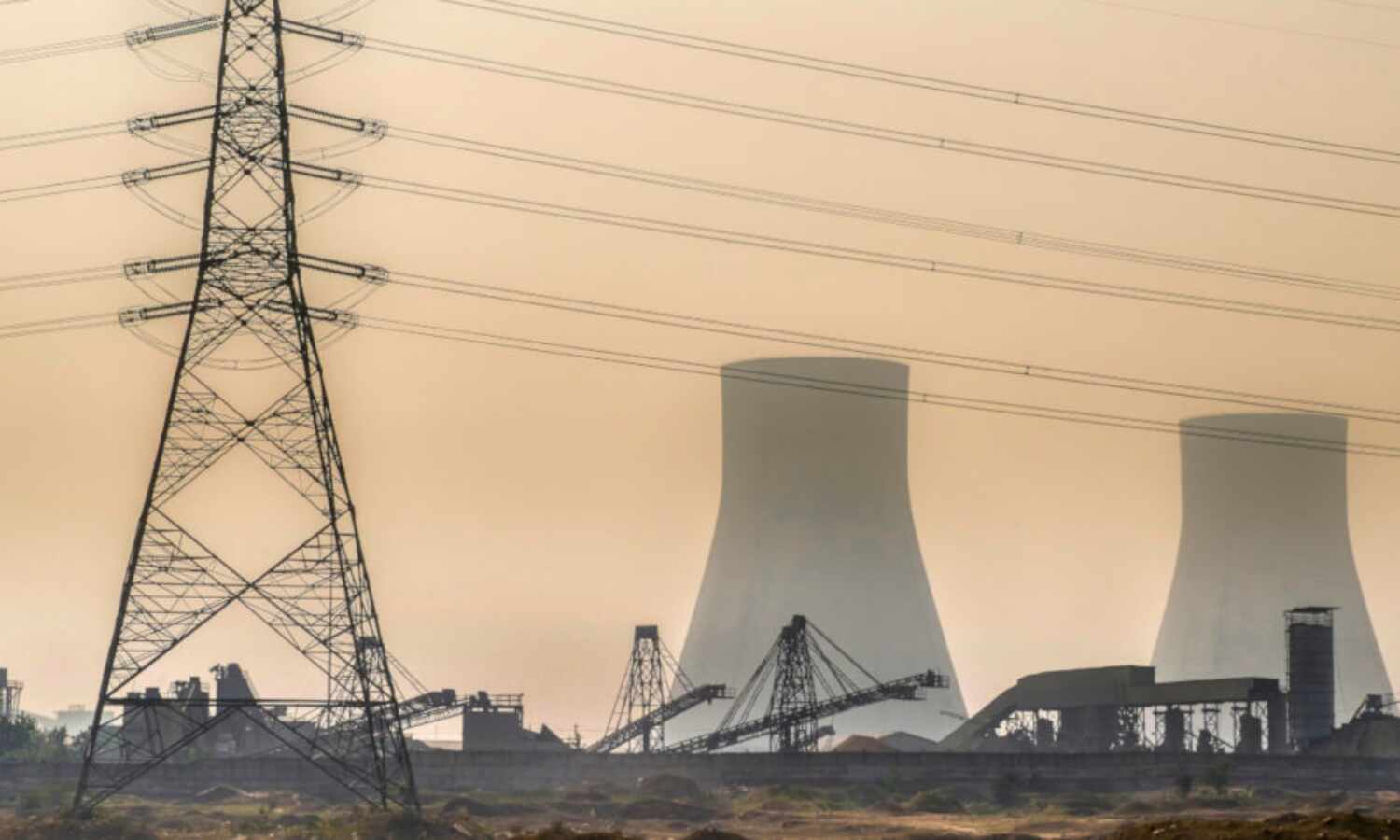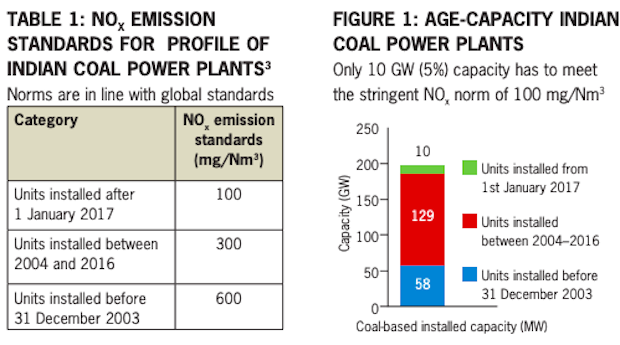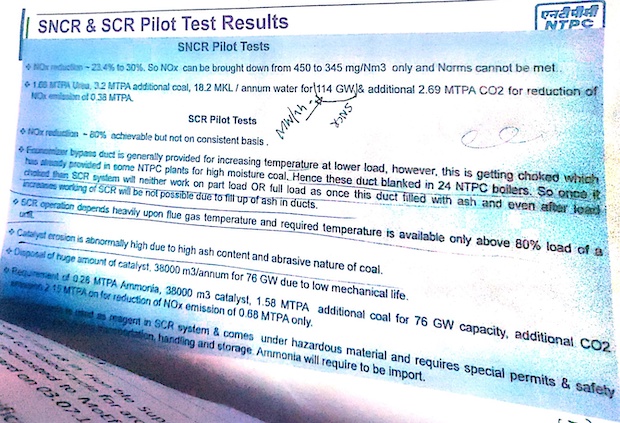India’s Largest Power Producer Wants NOx Norms Diluted For New Coal Plants

New Delhi: India’s power industry, led by its largest producer National Thermal Power Corporation (NTPC), is pushing to water down the norms for lethal oxides of nitrogen (NOx) emissions, saying pilot projects of technologies to cut down emissions have proved ineffective in India, as per documents reviewed by IndiaSpend.
The companies involved in the pilot projects have contested NTPC’s findings saying that NTPC did not allow these companies to make some primary modifications to the plants before conducting the tests, and that the technologies on their own had produced good results during the pilot and are currently used in China, Japan and European countries to reduce NOx pollution.
The results of these pilots, and NTPC’s claims, are important for an ongoing air pollution case at the Supreme Court that will determine whether Indian power plants can and must follow new, stricter norms. The court will also decide whether norms should be relaxed.
Under the new norms introduced in 2015, power plants commissioned between 2003 and 2016--which account for 65% of India’s total 197 gigawatt (GW, 1,000 megawatt) coal capacity--will have to cap their NOx emissions at 300 milligram per cubic metre (or mg/Nm3 where ‘N’ refers to standard temperature and pressure). New plants commissioned from 2017 onwards--that comprise 5% of total coal-based thermal power capacity--must limit NOx emissions to 100 mg/Nm3.
The government is already in the process of diluting the norms--for power plants that came up between 2003 and 2016 from 300 mg/Nm3 to 450 mg/Nm3, the central government affidavit to the apex court shows. The NTPC is now suggesting that norms for new plants commissioned after 2017 also be diluted from 100 mg/Nm3 to 450 mg/Nm3, our investigation found.
In effect, the magnitude of reduction in NOx limit for new plants (from 100mg/Nm3 to 450) mg/Nm3 is higher than that for older ones (from 300 mg/Nm3 to 450 mg/Nm3).
The 300 mg/Nm3 limit that applies to the majority of Indian plants is five times higher than that already being met by power plants in China. It is twice the norm in Germany and the European Union and more than three times that in the United States. Even the lowest Indian NOx norm of 100 mg/Nm3 is twice the world’s strictest norms of 50 mg/Nm3 set by China for its coal power plants. All of these countries are meeting their NOx norms using the same technologies rejected by NTPC, experts told IndiaSpend.
Documents that IndiaSpend has accessed show that ever since the declaration of new norms, the power industry has made multiple efforts to get the norms diluted--pleading lack of money or unavailability of technology.
Several studies (here and here), however, have proven that a range of technologies exist that enable Indian power plants to meet the prescribed norms. Installing NOx cutting technologies to achieve standards will cost Indian thermal plants between Rs 12,233 crore ($1.8 billion) and Rs 15,430 crore ($2.3 billion), a much lower cost than the health benefits of cutting this pollutant, studies have shown.
NOx is a toxic gas that can cause respiratory infections and sicken or kill people after it takes the form of PM 2.5–airborne particles 30 times finer than a human hair that enter the lungs. Power plants are one of the chief polluters of India’s air. Their emissions have been linked to 83,000 deaths annually in India. This number could go up to 186,500–229,500 deaths per year by 2030, by when India's total coal power capacity is expected to more than double to 450 GW (from the current 197 GW).
The move to dilute the standards comes after the government of India has already shifted the implementation deadline for NOx norms in power plants by five years to 2022, after they missed their original deadline of December 2017 to meet the new standards. Even after the delay, over half the capacity of India’s coal power plants are expected to miss the deadline of capping their emissions.
The pilot tests
The NTPC pilot included two technologies: Selective Catalytic Reduction (SCR) and Selective Non-catalytic Reduction (SNCR). These methods have been employed globally for more than 40 years to reduce NOx emissions by using ammonia or urea to break NOx into nitrogen and water.
Called secondary methods, they cut NOx from the smoke duct (known as the flue) post combustion. The cost of installing SNCR is about Rs 2 lakh per megawatt (MW), while for SCR, it is about Rs 10-15 lakh per MW.
Cheaper primary methods which reduce the production of NOx during combustion also exist. These methods include combustion modification through installing low-NOx burners (LNB), which reduce NOx by 30-50%, and Over Fire Air Burners (OFA), which reduce NOx by 20-45%. Combustion modifications cost about Rs 2 lakh per MW.
A power plant would have to use both the primary and secondary methods to lower emissions.
Indian power plants are considering primary modifications to meet the lenient standard of 600 mg/Nm3 for plants that are older than 2003 (known as vintage), and constitute 60 GW (30%) of India’s total installed capacity. The SNCR and SCR technologies were being considered for plants that have to achieve the new stricter targets of 300 mg/Nm3 and 100 mg/Nm3.
In 2017, the government of India said that these two technologies were not tested for India’s coal, which has a high amount of ash. The same year, NTPC set out to test these technologies in pilots at some of its units, our reporting showed.
NTPC had invited many international companies working with SCR and SNCR to conduct these pilots, including Doosan (South Korea), Mitsubishi (Japan), General Electric (USA) and Yara (Norway), according to documents accessed by IndiaSpend.
The results of the pilot would form the basis on which NTPC would invite tenders to finally implement the two technologies in its plants to meet the 2015 NOx emission standards. NTPC’s certificates for SCR and SNCR would also serve as a stamp of approval for the suitability of these technologies for other power plants in India.
The results are also awaited by the Supreme Court in the ongoing case on air pollution, where the court is reviewing the progress made by the power industry to abide by the new Indian emission standards of 2015, as we said.
The three-year-long tests started in April 2017. According to the timeline, NTPC should have published the results after all the plants had tried the technology for 4,400 running hours. Many of the companies completed this run around June-July 2019, but NTPC has not yet published the results. These results will show how much NOx was cut, among other details.
“The contract of the pilot project is ending in a few months’ time (by April 2020),” an official of one of the companies involved in the pilots told IndiaSpend, on the condition of anonymity. “We were first told that the results will publicly come out by September-October 2019, but nothing happened. Now we have reminded the NTPC again to issue the certificates.”
The NTPC presented the results of these pilots to India’s chief environmental agency, the Central Pollution Control Board (CPCB), in a meeting on November 2, 2019, where they declared that both the technologies “are not suitable for installation” in Indian power plants. The companies involved were not present at this meeting, sources told us.
IndiaSpend reached out to three companies involved in the NTPC pilot project through emails and phone calls, but they did not respond.
The NTPC then suggested that the norms for the new plants be diluted from 100 mg/Nm3 to 450 mg/Nm3. The diluted level can be achieved by “carrying out combustion modification and tuning of operational parameters”, NTPC said. These are the cheaper primary methods that we explained earlier.

A copy of the NTPC presentation slide from November 2, 2019
It is very difficult to believe that proven technology is not working for Indian plants, Vibhuti Garg, senior energy specialist at the International Institute for Sustainable Development (IISD), told IndiaSpend. An independent analysis by a non-government organisation is required to establish the claims made by NTPC, and the government should make public NTPC and other power plant emission data for a detailed analysis, she added.
“The emission limit for existing plants (300 mg/Nm3) is eminently achievable using a variety of techniques,” said Lauri Myllyvirta, lead analyst for the advocacy, Centre for Research on Energy and Clean Air (CREA), and a former member of a European Union technical working group that revised the emission limits for thermal power plants for the EU.
“If the government walks back regulations every time a polluter complains, there is no hope of meeting the (Indian government’s) National Clean Air Programme target of reducing PM 2.5 pollution by 20-30% by 2024,” Myllyvirta said.
IndiaSpend’s emails, including detailed questions to NTPC and CPCB, went unanswered even after repeated follow-up attempts for more than a week.

Source: Centre For Science and Environment
NTPC’s pilot test findings
NTPC’s presentation to the CPCB, reviewed by IndiaSpend, mentioned some of the issues related to both the technologies.
“(SIC) NOx reduction ~23.4% to 30%. So NOx can be brought down from 450 to 345 mg/Nm3 and Norms cannot be met,” the presentation said on SNCR. The presentation also cited the requirement of additional urea, coal and water as an issue.

The presentation from the NTPC meeting on November 2, 2019.
For SCR, the NTPC presentation accepted that the NOx reduction of nearly 80% could be achieved “but not on (a) consistent basis”. SCR can only work efficiently when flue gas has a certain required temperature that plants can only achieve when they are working above 80% of their capacity, the presentation said.
The presentation also mentioned several constraints faced during the pilot use of SCR technology in power plants, including the disposal of a huge amount of catalyst used in the SCR method and abnormally high erosion of the catalyst due to the high ash content and abrasive nature of Indian coal. It also said that there were space constraints in some plants to install SCR.
Post the NTPC presentation, the CPCB met some of these companies to discuss these issues, on November 7, 2019, according to internal communications accessed by IndiaSpend. Companies in this meeting rejected NTPC’s findings of the pilot projects, according to an audio recording of the meeting accessed by IndiaSpend. Representatives of NTPC did not join this meeting.
To some of the technical issues related to efficiency of SCR and SNCR raised during the November 7 meeting, one of the companies involved in the pilot projects informed CPCB that NOx emissions from Indian power plants could be reduced to 450 mg/Nm3 just by primary measures (combustion modifications). These could be further reduced to 280 mg/Nm3 and up to 80 mg/Nm3 if the primary measures are combined with SNCR and SCR, respectively.
Experts say problems with new technologies are solvable
Many of the problems of these technologies, except for high-ash content of coal, are not exclusive to India, and countries around the world have been successfully dealing with them, said experts.
Combustion modification can reduce NOx by another 20-30%, Soundaram Ramanathan, deputy programme manager of environment governance (energy) at the Centre for Science and Environment, a Delhi-based think-tank, told IndiaSpend.
Combustion modifications are a primary step before installing SCR or SNCR, as we explained earlier.
The CPCB knew from the beginning that these technologies would use additional urea, coal and water. And it is too minuscule--maybe less than 1-2% of the total use or CO2 emissions--but the benefits are much larger as NOx has higher global warming potential, Ramanathan said.
The problem of high ash content in Indian coal can easily be dealt with some engineering choices that power plants across the world are already making, Myllyvirta of CREA said.
China--which also uses high ash and low calorific value coal--has retrofitted hundreds of gigawatts of coal-fired capacity to comply with a NOx limit of 50 mg/Nm3, half of India’s strictest limit of 100 mg/Nm3, said Myllyvirta. Old coal-fired power plants in Japan and South Korea that have undergone retrofits routinely achieve emissions below 100 mg/Nm3, he added.
“It is always possible to install dust controls before the SCR to have low dust levels in the flue gas going into the SCR and avoid the issues NTPC is describing,” he said, adding that it cannot be a reason to not comply with the NOx standard.
“They (NTPC) have already retrofitted SCR systems to conduct the pilot in existing power stations,” Ramanathan of CSE said. “Currently denying that it is not possible to retrofit SCR is ambiguous. If space is unavailable then technical diagrams and other valid evidence should be included for further assessments,” she added, referring to the NTPC’s claim of not having space in the plants to install new technologies.
“The company (NTPC) could view this as an opportunity to improve the operation of the plants, but unfortunately its response so far has been to oppose any and all measures that would address the tremendous damage to air quality and public health its facilities are causing,” Myllyvirta said.
The lobbying
This is not the first time NTPC and the Indian power ministry have tried to dilute pollution norms for power plants.
In the Supreme Court case on air pollution, the government of India informed the Supreme Court that the level of 450 mg/Nm3 can be achieved through “combustion modification”, and hence that, for the plants that came up between 2003-2016, NOx norms will be relaxed from 300 mg/Nm3 to 450 mg/Nm3.
The government’s argument in the affidavit was based on a joint monitoring study conducted by the Central Electricity Authority of India (CEA) and CPCB between February and April 2019. For this study, both the authorities monitored emissions from seven units of four power plants that had combustion modifications--two plants of NTPC and two from a private generator, Adani Power.
Even though the study’s findings stated that emission standards with combustion modifications were achieved by five out of seven units monitored, representatives of India’s power and environment ministries, along with CEA, CPCB and NTPC officials, agreed to dilute the standards for plants that came up between 2003 and 2016 to 450 mg/Nm3, on May 7, 2019, the affidavit said.
“Out of 07 monitored units only 05 units were found complying with the NOx emission standards of 300 mg/Nm3 at full load only,” said the government’s affidavit submitted to the Supreme Court and reviewed by IndiaSpend.
The two units that could not comply with the 300 mg/Nm3 NOx norm belonged to Adani Power, that ran on “approximately full load”, as per the affidavit.
This joint study was conducted only because NTPC and the power ministry of India rejected CPCB’s claim--based on its continuous pollution monitoring data of plants--that most of India’s power plants were actually polluting well within the standard of 300 mg/Nm3 and new technologies would help it meet the emission standards, the Business Standard reported in August 2019.
Why this matters
In a decade to 2015, thermal power plants--among India’s chief polluters--pushed nationwide levels of NOx up by 20%, IndiaSpend reported on February 15, 2018. NOx creates more pollution than other forms such as dust. This is because these polluting gases remain in the air for 24-48 hours before turning into PM 2.5 which is also a pollutant.
If the Indian coal power plants had implemented the emission standard norms of NOx, SOx and PM by 2017, the original deadline, “approximately 76,000 premature deaths could have been averted”, Greenpeace, an international advocacy group, estimated in a December 2018 analysis. A 48% reduction in NOx emissions by 2017 alone could could have helped to avoid 28,000 deaths every year, the Greenpeace study said.
Source: Environment Protection Act, 2015
Health benefits outweigh technology costs
The power industry has also been using the cost of installing emission control technologies as an excuse to delay the retrofitting of coal power plants but, according to studies, the cost of retrofitting is much lower than its positive health impacts.
It will cost all Indian thermal plants between Rs 12,233 crore ($1.8 billion) and Rs 15,430 crore ($2.3 billion) in all for installing equipment to control NOx, according to an August 2019 joint study by IISD and the Council on Energy, Environment and Water (CEEW), a think-tank.
The total cost of retrofitting plants to control all three--SOx, NOx and PM--would be around Rs 73,176 crore ($10 billion) and Rs 86,135 crore ($12 billion). This would increase the cost of coal electricity by Rs 0.32-0.72 per kilowatt-hour or kWh (1 unit), the study said.
As the increased cost would be passed on to end-consumers, it is key that data from the continuous emission monitoring system (CEMS) devices installed in the emission stacks of plants be available to the electricity regulator (like Central Electricity Regulatory Commission) and the broader public to build confidence and show value, said Karthik Ganesan, research fellow, CEEW, and an author of the IISD and CEEW study. CEMS is a practice mandated by the Indian government in 2014 for power plants and 17 other grossly polluted industries of the country to monitor their pollution in real time.
Non-compliance with emissions norms would result in nearly 300,000-320,000 premature deaths and 51 million hospital admissions due to respiratory disorders over 11 years to 2030, the study estimated.
With pollution control spending of $0.28 per unit (Rs 19.95 at 2019 rates), the government can avoid $11.25 per unit (Rs 801.25) of health costs, the IISD and CEEW study said.
(Tripathi is an IndiaSpend reporting fellow.)
We welcome feedback. Please write to respond@indiaspend.org. We reserve the right to edit responses for language and grammar.


